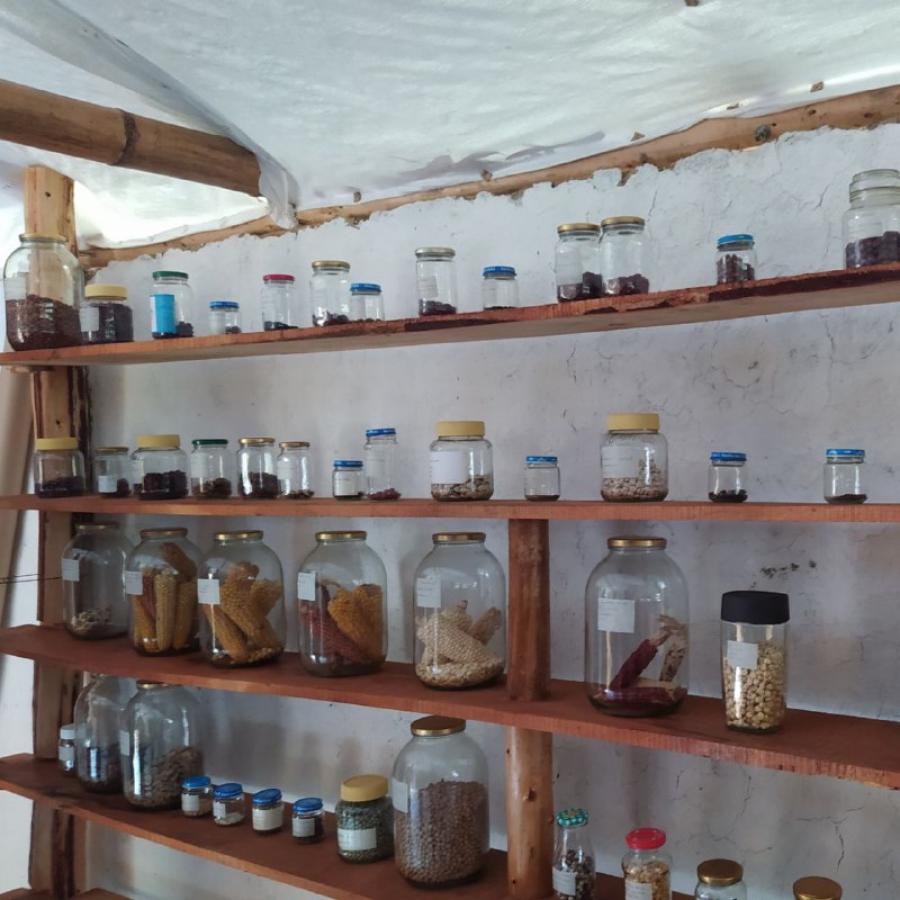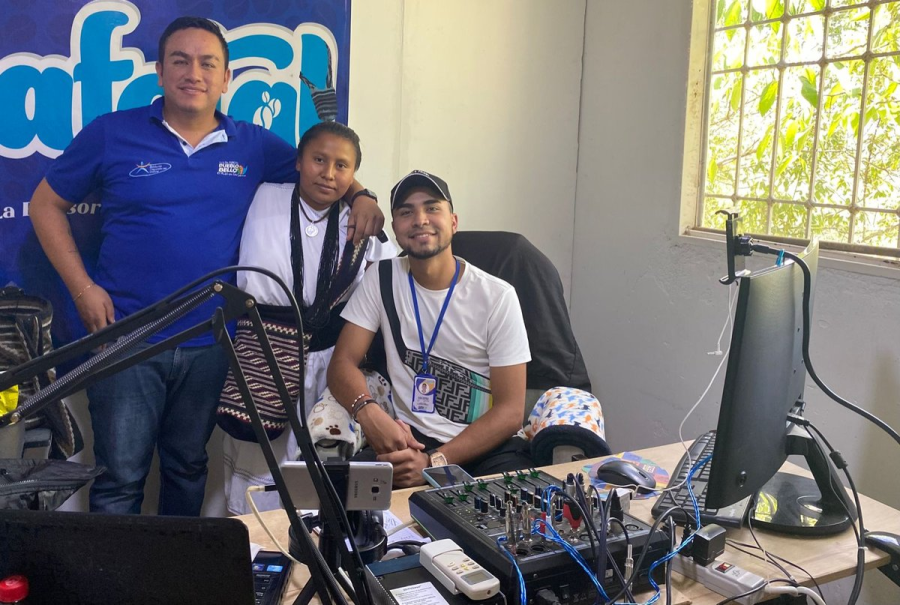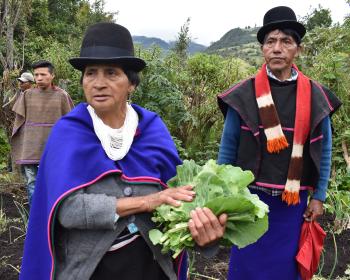In southern Colombia and the border regions of neighboring countries, distinct indigenous communities are menaced by the same sources of violence. The faces of those affected are varied and numerous, but women and children are the greatest victims. Within indigenous groups, the effect of the conflict on women has caused increasing alarm because women play a critical role in maintaining the social, economic, and cultural health of their communities. "Women in indigenous communities are important producers and reproducers of family life, thus carrying out a significant role in transmitting cultural values to future generations," said one indigenous leader from a non-governmental organization in Peru. "They are the ones who preserve our identity."
Women’s roles differ from one Andean indigenous community to the next. According to Olga Luz Restrepo Forero, an anthropologist and specialist in Andean communal relations, the administrative power that women hold varies significantly between groups. Among Wayúu, women are the heads of clans; they are the negotiators and representatives of communal interests, and speak as the voice of their community in conflicts. In other communities, such as the Embera, women hardly participate in the decision-making process. Regardless of the degree of their executive power, women have traditionally been protagonists in the preservation of ethnic identity. They provide for the social, economic, and cultural well-being of the next generation. Since the implementation of the first phase of Plan Colombia, various forces have robbed mothers of the power to guide their children’s and community’s fate and identity. Owing to forced displacement, economic crises, food shortages associated with aerial herbicide spraying of illicit crops, and the presence of guerrillas and other agents of violence, too many women have seen their children fall victim to the ravages of the Andean conflict. Meanwhile, they struggle to survive the health effects of the spraying and the devastating increase in exploitation and violence toward women.
Aerial Spraying
In the past several years, complaints have escalated among farmers and indigenous communities in Colombia’s Putumayo region and the border areas of Ecuador, Peru, Brazil, and Venezuela regarding the devastation of subsistence crops and the deaths of farm animals. Even more worrisome is the potential impact on human health. While herbal treatments and traditional remedies have helped Andean communities to heal the sick and provide women with prenatal care for thousands of years, aerial herbicide sprayings now cause new complications that are not cured by herbs. An indigenous leader from the Colombian Putumayo argues that indigenous women and children are the most vulnerable members of affected communities. Luis Ernesto Gonzales, spokesperson for the Organización de Pueblos Indígenas Amazónicos de Colombia (OPIAC), said that while females have traditionally played a critical role in ensuring the health and strength of their children, "women have seen many cases of children born with birth defects. Some have been born as Mongols, and others with different physical deformations." Beyond birth defects, Indians have said that normal childhood susceptibility has increased the number of reported illnesses. In one indigenous community in the Colombian province of Nariño, the sole local doctor told a reporter that the start of aerial herbicide spraying filled his waiting room with 80 percent of the community’s children--all covered with skin lesions.[1] The doctor said that he only had enough medicine for 10 percent of the children, and could consequently only treat the worst cases. "This is a medical drama: lesions, fever, diarrhea, eye infections . . . It all started after aerial herbicide spraying began," he explained. "Before then, only 10 percent of these children were sick, and with normal illnesses, like the flu and the mumps." The doctor explained that departmental authorities rejected his request for more medicine. He said Colombian authorities told him that the idea that aerial herbicide spraying affects human health was "a lie."
The case of this Colombian community demonstrates a sad fact prevalent in many of the region’s communities: Affected women and children are often unable to gain access to appropriate medical attention. Because of their precarious and impoverished economic situation, health problems--mild and severe--generally go untreated. In many cases, security rather than economic reasons preclude women from gaining access to healthcare. Eleonora, a leader from the Colombian NGO Mujeres Campesinas y Indígenas, explained that many women have health and childbirth problems because violence keeps them from leaving their homes to get medical attention. As the conflict swells in the Andean region, these problems become more severe.
Militarization and Sexual Violence
Plan Colombia and the Andean Regional Initiative have led to increased militarization of indigenous territory that was once accustomed to relative peace and privacy. As a female governor of two indigenous communities in Colombia reported: "The situation is difficult. One day the army passes through, the next day it’s the guerrillas, and the following day it’s the paramilitaries. We have lost lives in the process." The presence of armed actors in communal lands has not only threatened cultural identity and led to forced displacement, but has specifically and severely harmed women. With rising incidences of rape and of kidnappings, in which women are taken from their communities to be prostituted in cities, the escalating conflict in Colombia has become an even more acute threat to indigenous women’s rights.
Women in Colombia and border regions were menaced long before the initiation of Plan Colombia and the Andean Regional Initiative. Like any war, the Colombian conflict had victims, and indigenous women were not left unscathed. A female leader from the Wayuú community of Venezuela reported that many indigenous women who have migrated to the cities have been enticed to serve as mulas, or drug runners. She explained that these women are paid by narcotraffickers to carry drugs across the Colombia-Venezuela border--a tempting pursuit given critically high incidences of poverty and a lack of employment opportunities. Many of these indigenous women are subsequently apprehended and imprisoned.
According to reports by Amnesty International and MADRE, an international women’s rights organization, violence against women in the Andean region, especially rape and forced servitude, is systematic and widespread. All sides in the conflict stand accused of grave human rights violations, with the paramilitaries as the worst offenders, said Yifat Susskind, associate director of MADRE. The incidence of rape now present in Andean indigenous communities is an unprecedented phenomenon. The presence of armed agents, according to an indigenous leader from the border regions between Peru and Colombia, has led to the rape and violation of many women from his community. A leader from Putumayo corroborated this report, saying that women of this region have been both raped in their communities and taken to cities where they were sexually abused and exploited. He said that the women were induced to leave their communities, through false assurances of a more prosperous life in the city. Once away from their communities, they were sold into prostitution or simply abandoned and forced to fend for themselves. Eleonora said women are often victimized in revenge for acts of sympathy with opposing factions committed by absent male relatives.
Women’s freedom is further curtailed in conflict zones by decree of armed actors or by security considerations. All armed actors have been accused of killing independent social organizers and members of civil society. Eleonora explained that women are left with only two options: Leave the region, or stay and be dependent on male armed actors.
Physical and Cultural Displacement
The deleterious effects of Plan Colombia have led to a wave of displacement among regional indigenous communities--a physical displacement threatening an associated cultural displacement. According to indigenous leaders from the province of Putumayo, Plan Colombia has powerfully affected the ability of mothers to raise their children in the traditions of their native culture. Aerial herbicide spraying has led to the loss of subsistence crops that are "the fundamental basis of food security for Colombian indigenous populations," said Adriana Rodríguez, a human rights advocate with the Latin American Association for Human Rights. Migration necessitated by food and work shortages, personal danger, or orders from the government or other actors has emptied entire indigenous territories. Without food security or communal safety--critical to cultural survival--women and children either live in fear within their communities or leave them altogether.
According to MADRE, Colombia has the third-largest displaced population in the world, after Sudan and Angola. Rural indigenous peoples and Afro-Colombians are most affected. Fleeing the violence of Colombia, migrants pour into bordering countries, further affecting indigenous communities in these regions. Maria, a leader of the Colombian NGO Campesina Mista de Cauca ABRA, describes the gravity of the situation: "It is dangerous to live in a place where you become a military objective . . . And governments do not help refugees." According to Susskind: "Women account for more than 55 percent of all displaced people, and more than half of displaced families are headed by women. Because women’s social roles revolve around the home, women tend to carry the heaviest burden when a family is displaced and experience the most severe destruction of their social identity. Moreover, sexual abuse of displaced women and girls is [particularly] widespread. Most displaced families end up in overcrowded and impoverished urban slums. Almost 60 percent of displaced women have no job or source of income." This critical situation paints a frightening picture for the future of Andean indigenous families.
A group’s native land is the space within which mothers may nurture and educate their children without external interference. In the words of the vice president of CONFENIAE (Confederation of Indigenous Nationalities of the Ecuadoran Amazon), "Our territory is our life . . . A community without territory is a dead community." A Putumayo leader said that once children are away from their native lands, they stop going to school and learning about their heritage. They begin to lose their mother tongue, as well as the songs, traditions, mythology, indigenous dress, and native rites of their culture. Many youth get involved in the conflict, joining guerilla groups like the Revolutionary Armed Forces of Colombia (FARC) or the paramilitaries, or simply get involved in the crime, organized or otherwise, more prevalent in urban areas. Others merely leave home in order to look for food or job opportunities, such as harvesting coca, because their parents are no longer able to feed and support them. Migrant and refugee children--especially those who have been separated from or have left their parents--lack the cultural instruction necessary to retain the native traditions of their ancestors. This crisis of culture is a problem that affects the community as a whole, but it is above all a women’s issue. As the main protagonists in cultural preservation, women’s power to educate their children in traditional ways has been most usurped by the forces of Plan Colombia and the Colombian conflict.
An Uncertain Future
In a world where mothers are unable to raise their children and fortify their communities as they have for thousands of years, communal survival is dubious. As women are threatened by new sources of violence and destabilization, their communities’ cultural identities hang in the balance. Based on the effects that this conflict has already had on indigenous cultural identity and security, the impact on women cannot be ignored. Although often obscured by the macro-politics of war and anti-narcotics strategies, a women’s issue is at the heart of the violence. The voices of Andean indigenous communities cry out for peace, only to be ignored as the United States and the region’s national governments continue to pour millions of dollars into the militarization, herbicide spraying, and transformation of the region. National and international policy-makers who neglect the effects of their decisions on indigenous culture--and in particular, on the female preservers of that cultural identity--would be well advised to take heed.
1. Van Royen, M. (2000, Dec 28). Plan Bomba: Enloquecidos por la Picazón. Netherlands: NRC Handelsblad. Http://web.tiscali.it/dp_su/italiano/ plan_bomba.htm.
Katrina Kosec studies international political economy at Georgetown University's Edmund A. Walsh School of Foreign Service. Her work with the Center for Documentation in Human Rights, Segundo Montes Mozo, based in Quito, Ecuador, facilitated her research.



